Articles
Sustained Shared Thinking: A Practical and Comprehensive Guide for Early Years Practitioners
Posted on July 26, 2024.
In the world of early years education, Sustained Shared Thinking (SST) has emerged as a powerful tool for fostering children’s learning and development. But what exactly is SST, and how can it be effectively implemented in nursery settings?
SST is an educational technique that involves adults and children working together to explore ideas, solve problems, and clarify concepts. It goes beyond simple question-and-answer interactions, encouraging deeper, more meaningful exchanges that extend children’s thinking.
At its core, SST requires active listening and thoughtful, open-ended questioning from practitioners. These skills create an environment where children feel valued and encouraged to express their ideas freely.
The benefits of SST are significant. Research shows that children who experience high-quality SST often demonstrate:
- Improved cognitive abilities
- Enhanced language skills
- Better social and emotional development
SST can occur in various contexts throughout the day, from planned educational activities to spontaneous moments of curiosity. It’s a flexible approach that can be adapted to suit different learning styles and abilities, including children with special educational needs.
Implementing SST effectively requires a supportive environment, skilled practitioners, and thoughtful time management. This guide aims to provide early years professionals with the knowledge and tools needed to incorporate SST into their daily practice.
We’ll explore practical strategies for using SST, discuss how to overcome common challenges, and look at ways to measure its impact. We’ll also examine how to engage parents in SST, extending its benefits beyond the nursery setting.
Whether you’re new to SST or looking to enhance your existing practice, this guide offers valuable insights and practical advice to help you unlock the full potential of Sustained Shared Thinking in your early years setting.
What is Sustained Shared Thinking?
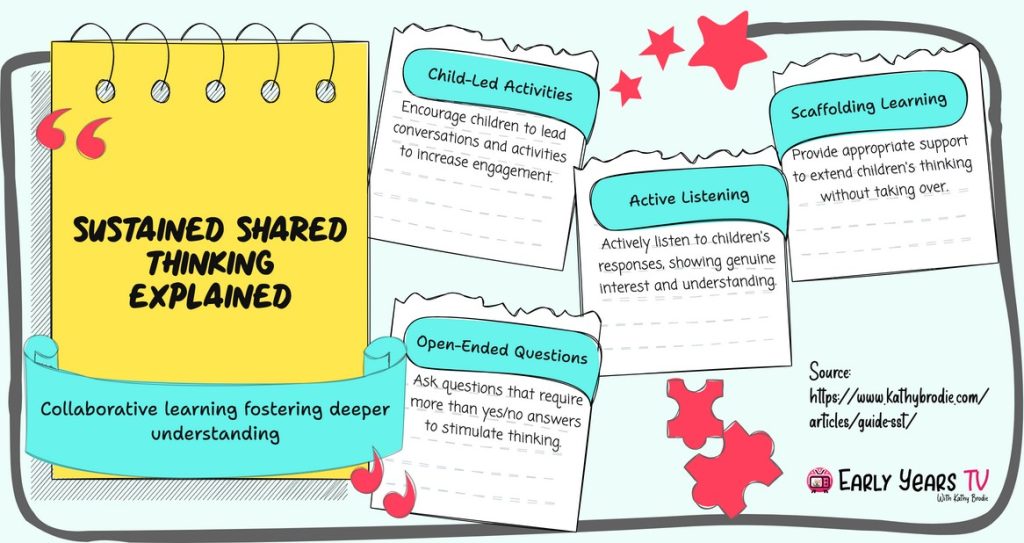
Sustained Shared Thinking is defined as:
“An episode in which two or more individuals ‘work together’ in an intellectual way to solve a problem, clarify a concept, evaluate activities, extend a narrative etc. Both parties must contribute to the thinking and it must develop and extend” (Siraj-Blatchford et al., 2002).
In practice, these are those beautiful, extended conversations you have with children where you’re both absorbed in the discussion or joint problem-solving. There’s a flow of information from both sides, and you’re using various ways to extend children’s learning and thinking.
For pre-verbal children, the ‘discussion’ may not be in words, but you can observe what fascinates them and how they approach problem-solving. You can then extend their thinking through physical interactions during play.
Why is it so powerful?
SST is a powerful technique because:
- It involves a two-way conversation, with both parties learning
- Children are at the centre, with you following their lead
- It improves children’s metacognition (thinking about thinking)
- It’s free – no special equipment needed
How can we achieve successful Sustained Shared Thinking?
Successful SST is built on two key skills:
- Active Listening: Being in the moment with children, encouraging discussions and allowing thinking to develop at the children’s pace.
- Positive Questioning: Sustaining discussions without taking over or overwhelming children with information or interrogation.
For example, when a child is intrigued by shadows in the playground, instead of explaining the science straightaway, you might ask, “What do you think makes the shadow move?” or a fascination with clouds may prompt the comment from the practitioner “I wonder what clouds are made of?”. This type of interaction encourages the child to share their ideas and theories, without the pressure of the feeling that there is a wrong or right answer.
When and Where are good times for Sustained Shared Thinking?
SST can happen throughout the day, but it’s particularly effective when:
- Children are relaxed and interested in their play
- There are minimal interruptions or distractions
Quiet areas like book corners, outdoor spaces or circle times can be ideal, but don’t discount those spontaneous moments of discovery and excitement.
Who can be involved with Sustained Shared Thinking?
All practitioners can initiate and encourage SST. You just need:
- Motivation to spot opportunities
- Skills in active listening and positive questioning
- Understanding the importance of SST
SST can also be very successful between children, especially in mixed-age groups. And don’t forget to encourage parents to extend conversations and problem-solve out loud with their children at home.
In the following sections, we’ll delve deeper into practical strategies for implementing SST, overcoming common challenges, and measuring its impact. Sustained Shared Thinking is such a powerful technique for supporting children that it would be a real shame not to use it. Yes, it requires some work and skill-honing, but being able to share ideas and thoughts with children is such a privilege and joy that it hardly seems like work!
Understanding Sustained Shared Thinking
Now that we’ve introduced the concept, let’s dive a bit deeper into what Sustained Shared Thinking really means in practice.
Key Components of SST
Sustained Shared Thinking isn’t just about having a chat with children. It’s a deliberate approach that involves several key elements:
- Joint attention: Both you and the child are focused on the same thing, whether it’s an object, an idea, a concept or a problem.
- Two-way communication: It’s not just you talking at the child, but a genuine back-and-forth exchange of ideas.
- Extending thinking: You’re helping to stretch the child’s understanding, not just confirming what they already know (and often stretching your own thinking!).
- Sustained interaction: These aren’t quick, fleeting moments, but extended periods of engagement.
Theoretical Underpinnings
SST isn’t just a nice idea – it’s grounded in solid educational theory. It draws heavily on Vygotsky’s concept of the Zone of Proximal Development (ZPD). This theory suggests that children can achieve more when they have the support of a more knowledgeable other (that’s you!) than they can on their own (Vygotsky, 1978).
Think of it like this: If a child is building a tower with blocks, their ZPD might be the point where they can build it a bit higher or more stable with your guidance. You’re not building it for them but offering just enough support to help them reach that next level.
SST in Action
Let’s look at an example to bring this to life:
Imagine you’re in the garden with 4-year-old Zara. She’s looking intently at a snail, watching its slow progress across a leaf.
You: “What do you notice about how the snail is moving?” Zara: “It’s really slow and leaving a shiny trail.” You: “That’s interesting! Why do you think it might be leaving that trail?” Zara: “Maybe… maybe it’s like painting a path?” You: “That’s a creative idea! The trail is actually something called mucus. It helps the snail move more easily. Can you think of anything else that might need help to move smoothly?”
This conversation demonstrates joint attention (on the snail), two-way communication, and how you’re gently extending Zara’s thinking beyond her initial observation.
Beyond Words
Remember, SST isn’t just about verbal communication. For younger children or those with language challenges, it might involve:
- Mirroring actions during play
- Using gestures and facial expressions
- Providing materials that extend their exploration
- Using a visual clues or objects of reference
The key is that you’re tuned into the child’s interests and helping to develop their understanding in a collaborative way.
By truly grasping these core elements of SST, you’ll be better equipped to spot opportunities for these rich interactions throughout your day.
The Benefits of Sustained Shared Thinking
Now that we’ve got a good grasp of what Sustained Shared Thinking is, let’s explore why it’s so beneficial for children’s development. The impact of SST is far-reaching, touching on several key areas of early learning.
Cognitive Development
SST is a powerhouse for boosting children’s thinking skills. When we engage in these extended, thoughtful interactions, we’re helping children to:
- Develop problem-solving skills: By working through ideas together, children learn to approach challenges systematically and have a framework to use in other circumstances.
- Enhance critical thinking: SST encourages children to question, analyse and evaluate ideas.
- Improve memory: The deep engagement involved in SST helps to cement new concepts in children’s minds.
For instance, when you’re building a den with 5-year-old Tom and ask, “How can we make this side more stable?”, you’re prompting him to think critically about structure and balance.
Language Skills
It’s probably no surprise that SST is brilliant for language development. These rich conversations provide:
- Vocabulary expansion: Children are exposed to new words in meaningful contexts.
- Practice in expressing ideas: SST gives children plenty of opportunities to articulate their thoughts.
- Improved listening skills: Children learn to pay attention to and build upon others’ ideas.
Imagine you’re exploring autumn leaves with 3-year-old Ava. As you discuss the colours and textures, you might introduce words like “crunchy”, “veins”, or “decay”, all within a context that’s meaningful to her.
Social and Emotional Growth
SST isn’t just about academic skills – it plays a crucial role in children’s social and emotional development too:
- Building confidence: Children feel valued when their ideas are taken seriously and they are listened to.
- Developing empathy: Through discussions, children learn to consider different perspectives, laying the foundations for Theory of Mind.
- Strengthening relationships: The one-on-one attention involved in SST helps to build strong bonds.
When 4-year-old Zain is upset about sharing a toy, engaging him in a conversation about feelings and fairness is SST in action, supporting his emotional development.
Metacognition and Self-regulation
Perhaps one of the most powerful benefits of SST is its impact on metacognition – thinking about thinking:
- Awareness of thought processes: Children become more conscious of how they – and you – arrive at ideas.
- Planning and reflection: SST encourages children to think ahead and look back on their learning.
- Self-regulation: As children engage in extended thinking, they practice focusing and controlling their attention.
For example, when you ask 5-year-old Maya, “How did you figure out how to balance those blocks?”, you’re prompting her to reflect on her own thinking process and to then verbalise it.
Long-term Impact
Research has shown that children who experience high-quality SST in early years settings tend to have better outcomes later in life. The EPPE project found that SST was a key feature of more effective pre-school settings, associated with better intellectual and social development in children (Sylva et al., 2004).
By incorporating SST into our daily practice, we’re not just supporting children’s immediate development – we’re laying the groundwork for lifelong learning and success.
In our next section, we’ll look at how to spot and create opportunities for these valuable SST moments in your setting.
Remember, every conversation is a chance to make a lasting impact!
Identifying Opportunities for Sustained Shared Thinking
Now that we understand the immense benefits of Sustained Shared Thinking, let’s explore how to spot and create these golden moments in our daily practice.
Recognising Child-initiated Cues
Often, the best SST opportunities arise from the children themselves. Keep an eye out for:
- Curiosity: When a child shows particular interest in something, it’s a perfect opening for SST. For some children this may be questions, but for others you will need to look out for more subtle clues such as gazing or repeat returning back to an activity.
- Questions: Children’s questions, even seemingly simple ones, can be springboards for deeper discussions.
- Problem-solving attempts: When you see a child trying to figure something out, it’s an invitation to engage in a suitable way.
For instance, when 4-year-old Lily is puzzling over why her plant isn’t growing as fast as her friend’s, that’s your cue to start a conversation about what plants need to thrive.
Creating an Environment Conducive to SST
While we can’t force SST to happen, we can certainly create conditions that make it more likely:
- Rich, open-ended resources: Materials like blocks, loose parts, or art supplies often spark interesting questions and ideas.
- Cosy, quiet spaces: Having areas where you can engage in one-to-one or small group conversations without interruption is crucial.
- Outdoor exploration: Nature is full of wonders and environmental provocations that can prompt deep thinking and discussion.
Consider setting up a ‘wondering wall’ where children can post questions or interesting objects they’ve found. This can be a great starting point for SST conversations.
Balancing Planned and Spontaneous SST Moments
While many SST interactions will happen spontaneously, it’s also worth planning for them:
- During routines: Even everyday activities like snack time can be opportunities for SST. “I wonder why some fruits float in water and others don’t?”
- In planned activities: When setting up activities, think about the questions or problems they might provoke.
- Story times: Books are fantastic SST prompts. “What do you think might happen next? Who do you think…?”
Remember, though, to stay flexible. Sometimes the most valuable SST moments come from unexpected directions!
Recognising SST Opportunities with Different Age Groups
SST looks different at different ages:
- Babies and toddlers: SST might involve mirroring actions, responding to coos and babbles, or exploring textures together.
- 2-3 year olds: Use lots of ‘I wonder…’ and ‘how’ questions. “How do you think we could make this tower taller?”
- 4-5 year olds: Encourage prediction and hypothesis. “What do you think would happen if we mixed these two colours?”
For example, when 18-month-old Zack is fascinated by a pinecone, you might explore it together, talking about how it feels and watching how it rolls.
Overcoming Barriers to SST
Sometimes, despite our best intentions, SST can be challenging. Common barriers include:
- Time pressures: It can be hard to find time for extended conversations in a busy setting.
- Large group sizes: It’s trickier to engage in deep discussions with many children at once (although not impossible).
- Lack of confidence: Some practitioners might feel unsure about extending children’s thinking or feel they should always be the ‘knowledgeable other’ and have all the answers.
We’ll address strategies for overcoming these challenges in a later section. For now, remember that even short SST interactions can be valuable. It’s about quality, not just quantity.
In our next section, we’ll delve into specific strategies for making the most of these SST opportunities. With practice, you’ll find yourself naturally weaving SST into your daily interactions with children, creating a richer, more stimulating learning environment for all.
Strategies for Effective Sustained Shared Thinking
Now that we’ve identified opportunities for Sustained Shared Thinking, let’s explore some practical strategies to make these interactions as effective as possible.
Active Listening Techniques
Active listening is at the heart of SST. It’s about truly hearing what children are saying, showing them that their ideas matter and giving them agency to take charge of their own learning.
- Give full attention: Turn towards the child, make appropriate eye contact (keeping in mind cultural appropriateness and the child’s preference), and show you’re listening through your body language.
- Use encouragers: Nod, smile, and use small verbal cues like “mm-hmm” to show you’re engaged, but don’t interrupt.
- Reflect back: Summarise what the child has said to check your understanding. “So, you think the ice melted because it was near the radiator?”
Remember, active listening isn’t just about ears – it’s about eyes, body, and mind too.
Open-ended Questioning
The right questions can open up a world of thinking. Here are some types to try:
- Possibility thinking: “What might happen if…?”
- Reasoning: “Why do you think…?”
- Evaluation: “How could we make this better?”
- Problem-solving: “What could we try to fix this?”
For instance, when 4-year-old Amir builds a bridge with blocks, instead of saying “That’s nice”, you might ask, “How did you decide where to put the supports?”
Scaffolding Children’s Ideas
Scaffolding is about providing just enough support to help children reach the next level of understanding.
- Extend vocabulary: Introduce new words in context. “Yes, the caterpillar is wriggling. It’s undulating its body to move along.”
- Model thinking: Share your own thought processes. “I’m wondering if we could use something sticky to join these pieces together.”
- Offer gentle challenges: Push thinking a bit further. “You’ve sorted these by colour. How else could we group them?”
Using the SSTEW Scale
The Sustained Shared Thinking and Emotional Wellbeing (SSTEW) scale is a useful tool for reflecting on and improving SST practice. It includes indicators such as:
- Supporting children’s concept development
- Encouraging children to talk with others
- Supporting children’s curiosity and problem solving
Although you may need specialist training to use the SSTEW scale effectively, you should consider using it to assess and develop your SST practice.
Embracing ‘Wait Time’
Sometimes, the most powerful thing we can do is… nothing. Giving children time to think is crucial.
- Give a 10 second pause: After asking a question, silently count to ten slowly before speaking again. This allows children to understand, formulate a response and speak.
- Resist the urge to fill silence: It’s okay if there are pauses in the conversation.
- Watch for non-verbal cues: Children might be thinking deeply even if they’re not speaking.
For example, when you ask 3-year-old Sasha what she thinks might be inside a seed, give her time to ponder before offering your own ideas.
Using Visual Aids and Props
Sometimes, concrete objects can help to spark and support thinking.
- Real objects: Having the actual item you’re discussing can lead to rich observations.
- Photos and pictures: These can be great for comparing and contrasting for older children.
- Drawing and mark-making: Encourage children to depict their ideas as you discuss them.
When exploring the concept of ‘floating and sinking’ with 5-year-old Leo, having a tub of water and various objects to test can lead to deeper engagement and understanding.
Remember, the goal of these strategies is not to lead the child to a predetermined answer, but to genuinely explore ideas together. In our next section, we’ll look at how to overcome some common challenges in implementing SST. With these strategies in your toolkit, you’re well on your way to fostering rich, thought-provoking interactions with the children in your care.
Overcoming Challenges in Implementing SST
While Sustained Shared Thinking offers tremendous benefits, it’s not without its challenges. Let’s explore some common hurdles and practical ways to overcome them.
Time Constraints
In busy settings, finding time for extended conversations can be tricky – this is usually the biggest and most often cited challenge, whatever type of setting you may be in, from childminder to day nursery to school.
Strategies to try:
- Maximise routine moments: Use daily activities like nappy changing or snack time for one-to-one interactions.
- Create ‘SST pockets’: Designate short periods throughout the day specifically for SST.
- Delegate tasks: Work with colleagues to free up time for quality interactions.
Remember, even brief SST moments can be valuable. It’s about making the most of the time you have.
Large Group Settings
It can be challenging to engage in deep thinking with many children at once.
Approaches to consider:
- Small group activities: Rotate children through small groups to allow for more focused interactions.
- Use open-ended questions: Pose questions that multiple children can respond to in different ways.
- Encourage peer discussions: Prompt children to share and build on each other’s ideas.
For instance, during circle time, you might ask, “What do you think makes a good friend?” This allows multiple children to contribute their thoughts.
Varying Developmental Levels
In mixed-age settings, meeting the needs of children at different stages can be complex.
Try these techniques:
- Differentiate questions: Tailor your questions to suit different abilities.
- Use peer scaffolding: Encourage more experienced children to support others.
- Provide varied resources: Offer materials that can be explored at different levels, such as loose parts.
When discussing shapes, you might ask a 3-year-old to find circles in the room, while prompting a 5-year-old to describe the properties of a circle.
Engaging Reluctant or Shy Children
Some children may be hesitant to engage in extended conversations.
Strategies to encourage participation:
- Start with interests: Begin conversations around topics the child is passionate about.
- Use non-verbal SST: Engage through shared activities like drawing or building.
- Create a safe environment: Ensure children feel their ideas are valued, no matter what.
For a quiet child who loves animals, you might begin by simply observing and commenting on the class pet together, gradually drawing out their thoughts.
Maintaining Adult-Child Ratios
Engaging in SST while maintaining oversight of the whole group can be challenging.
Consider these approaches:
- Team up: Work with colleagues to allow for one-to-one or small group interactions.
- Use observation areas: Create spaces where children can be seen while you interact with a small group.
- Incorporate SST into whole group activities: Use storytelling or group projects as SST opportunities.
Lack of Confidence or Knowledge
Some practitioners may feel unsure about extending children’s thinking, especially in areas they’re less familiar with.
Ways to build confidence:
- Embrace not knowing: It’s okay to learn alongside children. “I’m not sure why that happens. Shall we find out together?”
- Use open-ended resources: Materials like blocks or natural objects can lead to discussions in various directions.
- Seek professional development: Look for training opportunities to enhance your SST skills.
Remember, SST isn’t about having all the answers, but about exploring ideas together.
Cultural and Language Differences
In diverse settings, language barriers or cultural differences can impact SST.
Strategies to try:
- Use visual aids: Pictures, objects, and gestures can support communication.
- Learn key words: Familiarise yourself with important words in children’s home languages.
- Celebrate diversity: Use cultural differences as opportunities for rich discussions.
By addressing these challenges head-on, we can create more opportunities for meaningful SST interactions. In our next section, we’ll explore how to integrate SST across different areas of the Early Years curriculum, ensuring a holistic approach to this powerful teaching strategy.
Integrating SST Across the Early Years Curriculum
Sustained Shared Thinking isn’t just for specific ‘thinking time’ – it can and should be woven throughout all areas of the early years curriculum. Let’s explore how to integrate SST into various learning domains.
Literacy and Numeracy
These core areas offer abundant opportunities for SST:
Literacy:
- During storytime, ask open-ended questions: “What do you think the character will do next?”
- When mark-making, discuss the shapes and patterns: “What does this line remind you of?”
Numeracy:
- While counting objects, explore concepts: “We have more big cars than little cars. How can we make them the same?”
- When measuring ingredients for cooking, prompt predictions: “What do you think will happen if we add more flour?”
Remember, it’s not about getting the ‘right’ answer, but about encouraging children to think deeply and express their ideas.
Science and Exploration
The natural world is a treasure trove for SST:
- During nature walks, encourage observation: “What changes do you notice in the trees since last week?”
- When experimenting, prompt predictions: “What do you think will happen if we add these petals to the bowl?”
- Notice what is happening everywhere: “What different shapes can you see in the clouds today?”
For instance, while planting seeds with 4-year-old Mia, you might ask, “What do you think the seed needs to grow?”
Creative Arts
Art activities are perfect for fostering imaginative thinking:
- When painting, discuss colour choices: “What made you choose that colour for the sky?”
- During music time, explore sounds: “How could we make this instrument sound happy/sad/angry?”
Physical Development
Even active play can incorporate SST:
- When building obstacle courses, involve children in the design: “How could we make this part more exciting?”
- During ball games, discuss strategies: “What’s the best way to catch a bouncing ball?”
Personal, Social and Emotional Development
SST can greatly support children’s understanding of themselves and others:
- When resolving conflicts, encourage perspective-taking: “How do you think Jamal felt when you took his toy?”
- During circle time, explore emotions: “What sorts of things make you feel proud?”
Understanding the World
This broad area offers endless SST possibilities:
- When using technology, prompt problem-solving: “The computer isn’t working. What could we try?”
- During cultural celebrations, encourage comparisons: “How is this festival similar to or different from ones you celebrate at home?”
Tips for Cross-Curricular SST
- Follow the child’s lead: Be ready to explore whatever captures their interest, regardless of your planned focus.
- Make connections: Help children link new ideas to their existing knowledge and experiences.
- Use open-ended resources: Materials like blocks, playdough, loose parts, fabrics or natural objects can be used across multiple curriculum areas.
- Document thinking: Use mind maps, drawings, photos or videos to record and revisit children’s ideas.
- Collaborate with colleagues: Share SST strategies that work well in different curriculum areas or with different children.
Remember, SST isn’t about delivering curriculum content in a prescriptive way. It’s about using every opportunity to engage children in deeper thinking and discussion. By integrating SST across all areas of learning, we create a rich, interconnected educational experience that supports children’s holistic development.
In our next section, we’ll look at how to adapt SST strategies for children with Special Educational Needs and Disabilities (SEND), ensuring that all children can benefit from this powerful approach to learning.
Supporting SST for Children with Special Educational Needs and Disabilities (SEND)
Sustained Shared Thinking is a powerful tool for all children, including those with Special Educational Needs and Disabilities. However, we may need to adapt our approach to ensure these children can fully engage and benefit. Let’s explore some strategies for supporting SST for children with SEND.
Adapting Strategies for Diverse Needs
Every child is unique, and this is particularly true for children with SEND. Consider these approaches:
- Individualise your approach: What works for one child may not work for another. Observe closely and adjust your strategies accordingly.
- Allow extra time: Some children may need longer to process information or formulate responses.
- Break down concepts: Present ideas in smaller, manageable chunks.
For instance, when exploring the concept of ‘floating and sinking’ with 5-year-old Tom, who has autism, you might focus on one object at a time rather than presenting multiple items at once.
Using Visual Aids and Alternative Communication Methods
Visual supports can be invaluable for many children with SEND:
- Visual timetables: Help children understand and predict what’s coming next.
- Picture cards: Use these to represent ideas or choices.
- Objects of reference: Concrete items can help convey abstract concepts.
For non-verbal children, consider:
- Sign language: Learn key signs to support communication.
- Communication boards: These can help children express choices and ideas.
- Augmented and Alternative Technology (AAT): Explore apps or devices that can aid communication.
Creating a Supportive Environment
The right environment can make a big difference:
- Reduce sensory overload: Some children may need a quieter, calmer space for SST.
- Ensure physical accessibility: Make sure all areas are accessible for children with mobility needs.
- Provide fidget toys: These can help some children focus during conversations.
Focusing on Strengths and Interests
Building on a child’s strengths can boost engagement and confidence:
- Use special interests: If a child is fascinated by trains, use this as a springboard for SST.
- Celebrate diverse thinking: Recognise that children with SEND often have unique perspectives to offer.
For example, 6-year-old Ava, who has Down syndrome, loves music. You might use rhythm and song to explore mathematical concepts with her.
Collaborating with Support Staff and Specialists
Working together can enhance SST for SEND children:
- Share strategies: Discuss what works well with teaching assistants and other staff.
- Seek expert advice: Consult with speech therapists, occupational therapists, or other specialists for tailored strategies.
- Involve parents: They can provide valuable insights into their child’s communication style and interests.
Adapting Questions and Language
The way we phrase things can make a big difference:
- Use concrete language: Some children may struggle with abstract concepts.
- Offer choices: Instead of open-ended questions, you might ask, “Do you think it will sink or float?”
- Use visual supports: Accompany questions with pictures or gestures.
Recognising and Valuing Non-verbal SST
Remember, SST doesn’t always involve words:
- Observe closely: Notice how children engage with materials or respond to experiences.
- Value all forms of communication: A gesture, facial expression, or action can be just as meaningful as words.
For instance, when 3-year-old Zain, who has limited verbal communication, lines up cars by colour, you’re witnessing his thinking in action. You might extend this by offering a new colour and seeing how he responds.
Patience and Persistence
Supporting SST for children with SEND may require extra patience:
- Celebrate small steps: Recognise and value all attempts at engagement.
- Be consistent: Keep offering opportunities for SST, even if the child doesn’t always respond.
- Reflect and adjust: Regularly review what’s working and be prepared to try new approaches.
Remember, every child has the capacity for deep thinking and learning. By adapting our SST strategies to meet diverse needs, we can ensure all children have the opportunity to engage in rich, meaningful learning experiences.
In our next section, we’ll explore how to develop practitioner skills for SST, helping you and your team become more confident and effective in using this powerful approach.
Developing Practitioner Skills for SST
Becoming proficient in Sustained Shared Thinking is an ongoing journey and you will have some strategies that are more natural for you than others. Let’s explore some of these strategies to help you and your team enhance your SST skills.
Self-reflection and Evaluation
Regular self-reflection is key to improving your SST practice:
- Keep a reflective journal: Jot down SST moments, noting what worked well and what you might do differently.
- Video yourself: With appropriate permissions, record some of your interactions for later analysis.
- Use a self-evaluation tool: Consider using the SSTEW scale to assess your practice.
For example, you might reflect on a conversation you had with 4-year-old Ava about shadows. Did you ask open-ended questions? Did you give her enough time to respond? Have you returned to the conversation? What further opportunities could you provide in the continuous provision?
Peer Observation and Feedback
Learning from colleagues can be incredibly valuable:
- Buddy system: Partner with a colleague to observe each other’s SST practice.
- Team teaching: Work alongside a more experienced practitioner to learn new strategies.
- Share successes: Discuss effective SST moments in team meetings.
Remember, the goal isn’t to criticise, but to learn and grow together.
Continuous Professional Development
There are many ways to expand your SST knowledge and skills:
- Attend workshops: Look for training specifically focused on SST or related topics like questioning techniques.
- Online courses: Consider e-learning options that allow you to study at your own pace.
- Read widely: Stay up-to-date with current research and practice in early years education.
Practising Active Listening
Active listening is at the heart of SST. Try these exercises to hone your skills:
- The silent game: Practice listening to a colleague for one minute without interrupting.
- Paraphrasing practice: After a conversation, try summarising what the other person said.
- Non-verbal cues: Pay attention to body language and facial expressions during interactions.
Expanding Your Question Repertoire
Develop a bank of open-ended questions to use in different situations:
- Question challenge: Each day, try to use a new type of open-ended question.
- Question audit: Review your questions at the end of the day. Were they truly open-ended?
- Create a team question bank: Collaborate with colleagues to compile effective questions.
Building Your Knowledge Base
The more you know, the more you can engage in meaningful SST:
- Follow children’s interests: If a child is fascinated by dinosaurs, brush up on your palaeontology!
- Stay curious: Model lifelong learning by exploring new topics yourself.
- Use reliable resources: Know where to find accurate information when you need it.
Developing Emotional Intelligence
SST isn’t just about cognitive skills – emotional intelligence is crucial too:
- Practice empathy: Try to see situations from the child’s perspective.
- Manage your emotions: Be aware of how your own feelings might impact interactions.
- Create a feelings vocabulary: Expand the language you use to discuss emotions with children.
Embracing a Growth Mindset
Remember, becoming skilled at SST is a process:
- Celebrate mistakes: View challenges as opportunities to learn and grow.
- Seek feedback: Be open to constructive criticism from colleagues and managers.
- Set personal goals: Regularly set and review targets for your SST practice.
For instance, you might set a goal to engage in at least three extended SST interactions each day, gradually increasing this over time.
Creating a Culture of SST
Encourage a setting-wide focus on SST:
- Lead by example: Model SST in your interactions with both children and adults.
- Discuss SST regularly: Make it a standing item in team meetings.
- Celebrate SST moments: Recognise and praise colleagues when you observe effective SST.
Remember, developing your SST skills is an ongoing process. Be patient with yourself and celebrate your progress along the way. By continually reflecting on and refining your practice, you’ll be better equipped to provide rich, meaningful learning experiences for the children in your care.
In our next section, we’ll explore how to engage parents and caregivers in SST, extending the benefits of this approach beyond the setting and into children’s homes.
Engaging Parents and Caregivers in SST
Sustained Shared Thinking doesn’t stop at the setting’s door. By involving parents and caregivers, we can extend the benefits of SST into children’s home environments. Let’s explore some strategies for engaging families in this powerful approach.
Sharing SST Strategies with Families
Help parents understand and use SST at home:
- Parent workshops: Organise sessions to introduce SST concepts and techniques.
- Information leaflets: Create easy-to-read guides with practical SST tips.
- Regular updates: Share examples of SST moments in your setting’s newsletter or social media.
For instance, you might create a simple handout titled “5 Easy Ways to Encourage Thinking at Home”, featuring ideas like asking open-ended questions during bedtime stories.
Encouraging SST in Home Environments
Provide concrete ideas for SST opportunities at home:
- Daily routines: Suggest ways to incorporate SST into everyday activities like cooking or bath time.
- ‘Think together’ challenges: Set simple tasks for families to explore together, like “How many different ways can you sort your socks?”
- Question prompts: Offer a list of open-ended questions parents can use in various situations.
Remember, the goal is to make SST feel achievable, enjoyable and fun, not like another chore for busy parents.
Building Two-Way Communication
Create opportunities for parents to share their SST experiences:
- SST journals: Encourage families to record thinking moments at home and share these with you.
- Parent-child projects: Set tasks that involve SST and can be completed at home, then discussed in the setting.
- Regular check-ins: Use drop-off and pick-up times to briefly discuss recent SST moments.
For example, you might ask 5-year-old Zara’s dad, “Zara was fascinated by shadows yesterday. Have you noticed her exploring this at home?”
Adapting to Diverse Family Contexts
Remember that every family is unique:
- Multilingual families: Encourage SST in home languages. Provide key SST phrases in various languages.
- Different family structures: Ensure your communication is inclusive of all family types.
- Cultural sensitivity: Be aware that conversation styles and adult-child interactions vary across cultures.
Using Technology to Support Home-Setting SST Links
Leverage technology to bridge the gap between home and setting:
- Apps and websites: Recommend child-friendly apps or sites that encourage thinking skills.
- Video demonstrations: Create short clips showing SST in action to share with parents.
- Online platforms: Use your setting’s online learning journal to highlight SST moments and suggest follow-up activities.
Celebrating Home Learning
Recognise and value SST happening at home:
- SST display board: Create a space where families can share their thinking moments.
- Show and tell: Invite children to discuss SST experiences from home during circle time.
- Family SST awards: Consider simple certificates or stickers for families engaging in SST.
Supporting Parents’ Confidence
Some parents might feel unsure about engaging in SST:
- Emphasise everyday opportunities: Show how SST can happen during normal routines, not just in ‘educational’ moments.
- Start small: Encourage parents to begin with just one or two SST strategies and build from there.
- Provide reassurance: Remind parents that it’s okay not to have all the answers. Learning together is valuable too!
For instance, you might say to a parent, “Remember, when Ethan asks ‘why’ for the hundredth time, it’s a great chance to explore ideas together!”
Addressing Common Challenges
Be prepared to support parents with SST hurdles:
- Time constraints: Suggest quick SST moments that can fit into busy schedules.
- Multiple children: Offer ideas for engaging siblings of different ages in SST together.
- Reluctant children: Provide strategies for making SST feel like fun, not work.
Remember, the key is to make SST feel manageable and enjoyable for families. By working together with parents and caregivers, we can create a rich, thinking-focused environment that extends far beyond our settings.
In our final section, we’ll explore ways to measure the impact of SST in your setting, helping you to refine your practice and demonstrate the value of this approach to stakeholders.
Measuring the Impact of SST
Assessing the effectiveness of Sustained Shared Thinking is crucial for refining our practice and demonstrating its value. Let’s explore various methods to measure the impact of SST in your setting.
Observation and Documentation Methods
Careful observation is key to understanding SST’s impact:
- Learning journals: Record detailed SST interactions, noting children’s responses and developments over time.
- SST tally charts: Track the frequency and duration of SST moments throughout the day.
- Location: Keep a note of where the most SST happens or keep a chart in each area of your setting and tick when there is a SST interaction in that area.
- Video observations: With appropriate permissions, record SST interactions for later analysis.
For example, you might note how 4-year-old Amir’s problem-solving skills develop over a series of SST interactions about building structures.
Using Assessment Frameworks
Incorporate SST into your existing assessment practices:
- SSTEW scale: Use this specifically designed tool to evaluate your SST provision.
- Early Years Foundation Stage (EYFS): Link SST moments to the characteristics of effective learning and areas of learning and development.
- Individual education plans: For children with SEND, include SST-related targets and track progress.
Remember, the goal is to use these frameworks to support children’s learning and to help your own CPD, not to create unnecessary paperwork.
Tracking Language Development
SST can have a significant impact on children’s language skills:
- Vocabulary charts: Record new words introduced and used during SST interactions.
- Conversation length: Note any increases in the duration of children’s contributions to discussions.
- Complexity of language: Observe children’s use of more sophisticated sentence structures or reasoning words (because, therefore, etc.).
Monitoring Cognitive Skills
Look for improvements in thinking skills:
- Problem-solving abilities: Note how children approach challenges before and after regular SST.
- Creativity: Observe any increases in children’s imaginative thinking or novel ideas.
- Critical thinking: Watch for children asking more probing questions or considering alternative viewpoints.
For instance, you might track how 5-year-old Zoe’s approach to building a den evolves over time, becoming more planned and considered.
Assessing Social and Emotional Development
SST can support children’s personal, social and emotional growth:
- Emotional vocabulary: Note expansions in children’s ability to express and discuss feelings.
- Empathy: Observe children’s growing awareness of others’ perspectives (Theory of Mind).
- Confidence: Track children’s willingness to share ideas or take on challenges.
Gathering Feedback
Don’t forget to collect views from others:
- Child voice: Ask children about their experiences. “What’s your favourite thing to think about with a grown-up?”
- Parent surveys: Gather feedback on any changes parents notice at home.
- Team reflections: Regularly discuss the impact of SST in staff meetings.
Long-term Benefits and Research Findings
While some impacts of SST may be immediately observable, others might only become apparent over time:
- Transition information: Liaise with receiving schools to understand how children who’ve experienced SST fare in their next setting.
- Research participation: Consider participating in academic studies on SST to contribute to the wider evidence base.
Creating Case Studies
In-depth case studies can provide rich evidence of SST’s impact:
- Individual child studies: Track a child’s journey with SST over an extended period.
- Thematic studies: Focus on how SST supports a particular area of learning, like scientific thinking.
For example, you might create a case study on how SST supported 3-year-old Mia’s understanding of change over time as she observed caterpillars transforming into butterflies.
Using Technology for Impact Measurement
Leverage digital tools to support your impact measurement:
- Learning journey software: Use digital platforms to tag and track SST moments over time.
- Data analysis tools: Consider using simple spreadsheets or apps to spot trends in your SST data.
Remember, measuring impact isn’t about creating perfect learners or ticking boxes. It’s about understanding how SST is supporting children’s development and how we can continually improve our practice.
By thoughtfully measuring the impact of SST, we can not only refine our approach but also advocate for its importance in Early Years education. After all, when we can demonstrate the power of rich, meaningful interactions, we’re championing quality early years practice for all children.
Conclusion: Embracing Sustained Shared Thinking in Your Setting
As we wrap up our exploration of Sustained Shared Thinking, let’s take a moment to reflect on the journey we’ve undertaken together.
We’ve delved into what, why, and how of SST, uncovering its potential to transform our interactions with young children. From understanding its theoretical underpinnings to exploring practical strategies for implementation, we’ve seen how SST can enrich our Early Years practice.
Key takeaways include:
- SST is more than just conversation; it’s a deliberate approach to extend children’s thinking and understanding.
- There are recognised strategies that can help practitioners to improve their SST, even if they are not confident at first.
- It can be used across all areas of the curriculum and with children of all ages, including babies and toddlers.
- Successful SST relies on skills like active listening and positive questioning, which can be developed with practice.
- Overcoming challenges, such as time constraints or engaging reluctant children, is possible with creative approaches.
- Involving parents and caregivers can extend the benefits of SST beyond the setting.
Remember, implementing SST isn’t about perfection. It’s about creating an environment where thoughtful, extended interactions become a natural part of your daily practice. Start small, perhaps focusing on one or two SST interactions each day and build from there.
As you embark on your SST journey, keep in mind that every deep conversation, every shared problem-solving moment, is an opportunity to make a lasting impact on a child’s cognitive, social, and emotional development.
The beauty of SST lies in its simplicity. It doesn’t require expensive resources or complex training. It simply asks us to be present, to listen actively, and to engage genuinely with children’s ideas and theories about the world.
So, as you return to your setting, I encourage you to look for those SST moments. They might occur during a quiet one-to-one interaction, in the midst of bustling group play, or during everyday routines like snack time. Wherever they happen, seize them. Extend them. Relish them.
By embracing Sustained Shared Thinking, you’re not just improving your practice – you’re nurturing the thinkers, problem-solvers, and innovators of tomorrow. And that is truly powerful.
Remember, the journey doesn’t end here. Continue to reflect on your SST practice, share experiences with colleagues, and stay curious. After all, we’re on this learning journey alongside the children in our care.
Here’s to richer conversations, deeper understanding, and the joy of thinking together!
Frequently Asked Questions
How is SST Different from Regular Conversation with Children?
Question: How does Sustained Shared Thinking differ from everyday conversations we have with children?
SST goes beyond casual chat. It’s a deliberate approach where both adult and child contribute ideas, working together to solve problems or develop understanding. Unlike everyday talk, SST:
- Involves extended back-and-forth exchanges
- Focuses on deep thinking and problem-solving
- Requires active listening and thoughtful questioning from the adult
- Aims to extend the child’s thinking and understanding
For example, instead of simply answering a child’s question about why leaves change colour, you might explore the idea together, asking what they think and building on their ideas.
Can SST Be Used with Babies and Toddlers?
Question: Is Sustained Shared Thinking only for older children, or can it be used with babies and toddlers too?
Absolutely, SST can and should be used with our youngest learners! With babies and toddlers, SST might look like:
- Mirroring and extending their vocalisations
- Narrating their actions during play
- Responding to their non-verbal cues and extending their explorations
For instance, when a baby is fascinated by a shiny object, you might explore it together, talking about how it feels, sounds, and moves. The key is to follow their lead and extend their interest through your interactions.
Remember, early SST experiences lay the foundation for later, more complex thinking skills (Siraj-Blatchford, 2009).
How Can I Find Time for SST in a Busy Setting?
Question: Our setting is always so busy. How can we make time for Sustained Shared Thinking?
Finding time for SST in a bustling environment can be challenging, but it’s not impossible:
- Utilise routine moments: Nappy changes, mealtimes, and transitions can all be opportunities for one-to-one SST.
- Create ‘SST pockets’: Designate short periods throughout the day specifically for focused interactions.
- Rotate staff: Take turns engaging in SST while colleagues manage the wider group.
- Integrate SST into planned activities: Design activities that naturally lend themselves to deep thinking and discussion.
Remember, even brief SST moments can be valuable. It’s about quality, not just quantity.
What If a Child Doesn’t Seem Interested in SST?
Question: What should I do if a child doesn’t seem interested in engaging in Sustained Shared Thinking?
Not every child will immediately engage in SST, and that’s okay. Here are some strategies to try:
- Start with the child’s interests: Base your SST attempts around topics or activities the child enjoys.
- Keep it playful: Frame SST as a fun exploration rather than a serious discussion.
- Use concrete objects: Sometimes, having something tangible to explore can spark interest.
- Be patient: Some children may need time to warm up to this style of interaction.
- Consider timing: A child who’s tired, hungry, or overstimulated may not be ready for SST.
If a child consistently seems uninterested, reflect on whether your approach needs adjusting. Are you following their lead? Are your questions age-appropriate? Remember, SST should feel natural and enjoyable, not forced.
How Can We Measure the Impact of SST?
Question: We’re implementing SST in our setting, but how can we measure its impact?
Measuring the impact of SST involves both qualitative and quantitative approaches:
- Observations: Record detailed SST interactions, noting children’s responses and developments over time.
- Language tracking: Monitor improvements in vocabulary, conversation length, and complexity of language use.
- Problem-solving skills: Observe how children’s approach to challenges evolves.
- Social-emotional development: Track changes in children’s emotional vocabulary, empathy, and confidence.
- Parent feedback: Gather insights from families about changes they notice at home.
- Standardised tools: Consider using the SSTEW scale or linking SST to EYFS assessments.
Remember, some benefits of SST may only become apparent over time. Consider creating long-term case studies to capture the full impact of your SST practice.
For more detailed strategies, refer to the ‘Measuring the Impact of SST’ section in this guide.
References
- Siraj-Blatchford, I., Sylva, K., Muttock, S., Gilden, R., & Bell, D. (2002). Researching effective pedagogy in the early years. Department for Education and Skills.
- Sylva, K., Melhuish, E., Sammons, P., Siraj-Blatchford, I., & Taggart, B. (2004). The Effective Provision of Pre-School Education (EPPE) Project: Final Report. Institute of Education, University of London.
- Vygotsky, L. S. (1978). Mind in society: The development of higher psychological processes. Harvard University Press.
- Siraj-Blatchford, I. (2009). Conceptualising progression in the pedagogy of play and sustained shared thinking in early childhood education: A Vygotskian perspective. Educational and Child Psychology, 26(2), 77-89.
Kathy Brodie Sustained Shared Thinking: A Practical and Comprehensive Guide for Early Years Practitioners. Available at: https://www.kathybrodie.com/articles/guide-sst/ (Accessed: 05 April 2025)o.


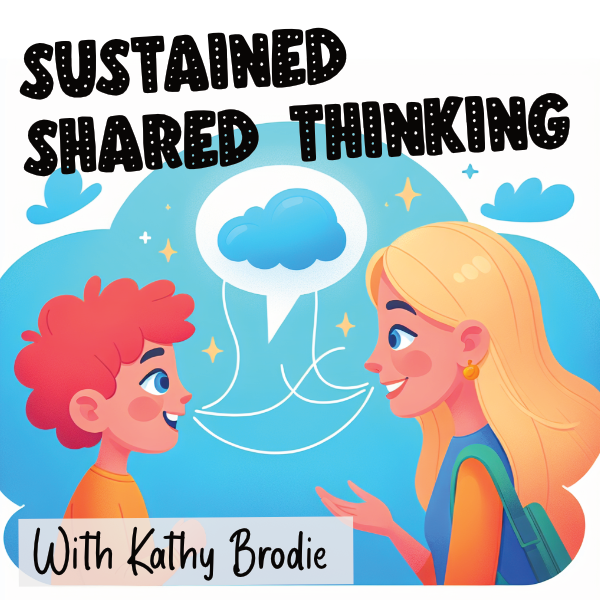
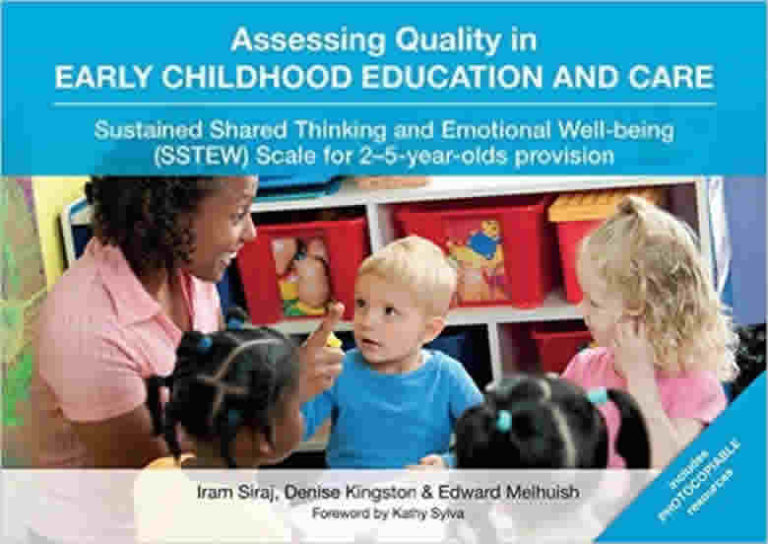


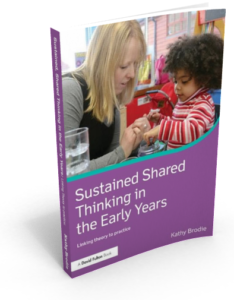



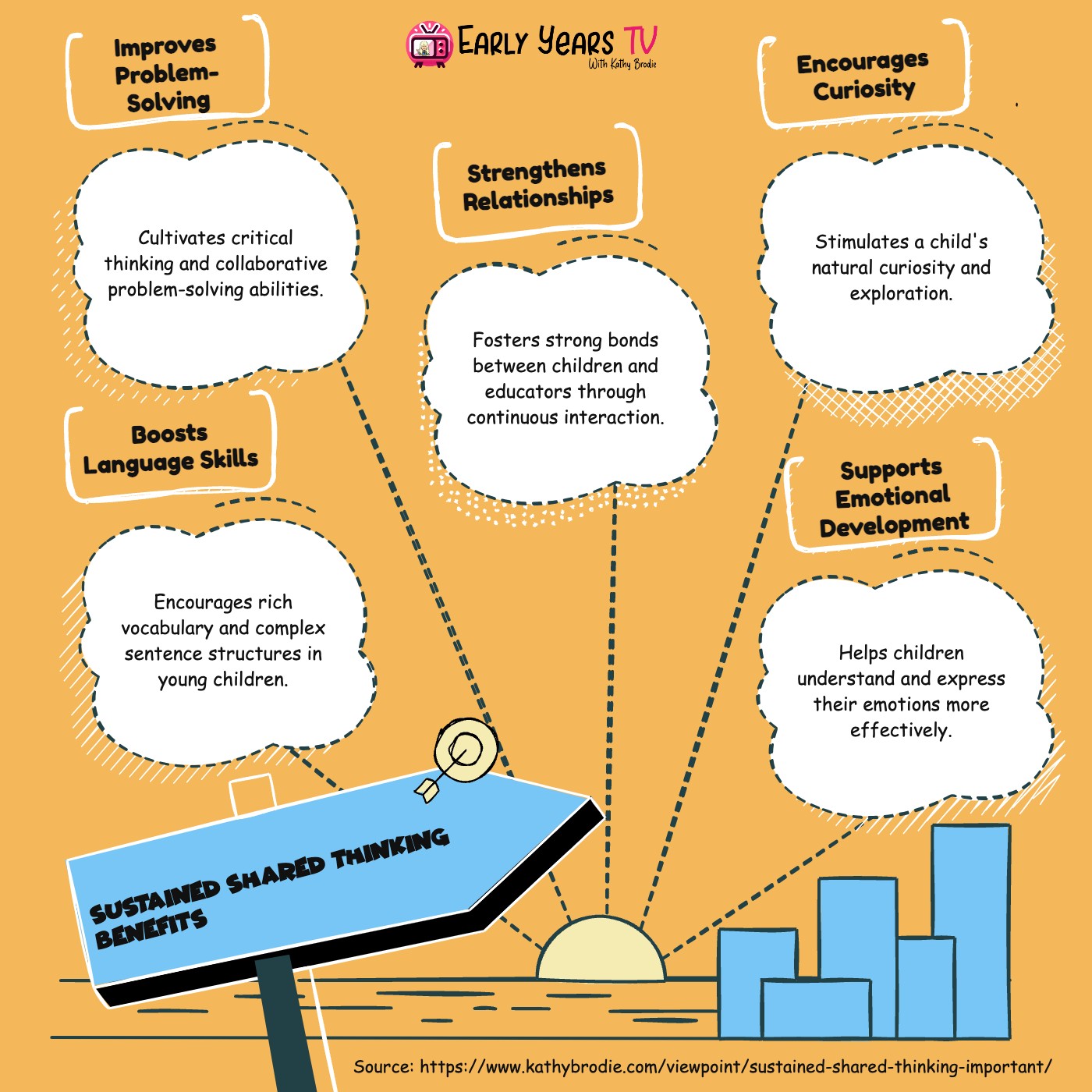
 I read with no surprise the results from the Unicef report, and the resultant reporting in the Times yesterday (11th December 2008). When all the hype and comment has been cleaned away the nugget of truth left is that a child from a disadvantaged background does not benefit from poor quality day care. Hardly earth shattering. Maria Montessori had spotted this over 100years ago. More recently the EPPE research has proved it.
I read with no surprise the results from the Unicef report, and the resultant reporting in the Times yesterday (11th December 2008). When all the hype and comment has been cleaned away the nugget of truth left is that a child from a disadvantaged background does not benefit from poor quality day care. Hardly earth shattering. Maria Montessori had spotted this over 100years ago. More recently the EPPE research has proved it.